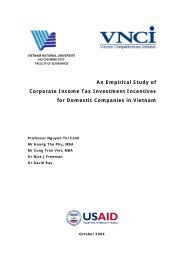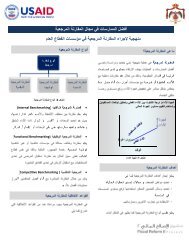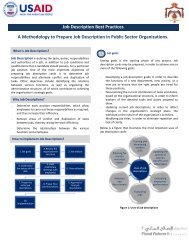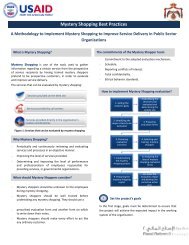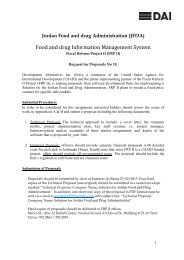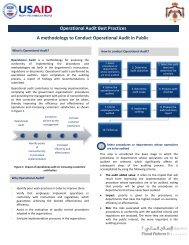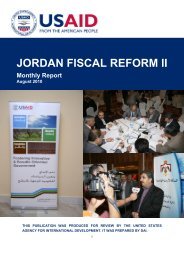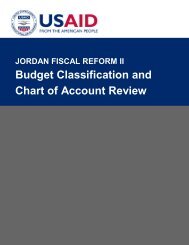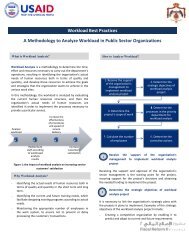Integrated Financial Management Information Systems: A ... - Frp2.org
Integrated Financial Management Information Systems: A ... - Frp2.org
Integrated Financial Management Information Systems: A ... - Frp2.org
You also want an ePaper? Increase the reach of your titles
YUMPU automatically turns print PDFs into web optimized ePapers that Google loves.
Box 1. Double-entry bookkeeping and modern financial management<br />
<strong>Financial</strong> management information systems are not a new phenomenon. On the contrary, the recording of financial<br />
information is the oldest known form of record keeping, dating back thousands of years. Yet financial information<br />
has long presented problems, particularly since the invention of money. It was only late in the 15th century when<br />
Luca Pacioli, an Italian mathematician, set out to codify the “double-entry” accounting system that modern<br />
financial management began to develop.<br />
All modern financial management information systems—including those used in the private sector and in the<br />
public sector—are based on Pacioli’s technical innovation. The system is called “double-entry” because each<br />
transaction involves an exchange between two accounts: debits and credits. For every debit, there is an equal and<br />
opposite credit; the sum of all debits must therefore equal the sum of all credits. This balancing requirement is<br />
critical, as it makes it easier to detect errors or discrepancies in the recording of transactions. Moreover, because it<br />
provides a full picture of the financial situation of an organization, double-entry accounting also facilitates the<br />
preparation of financial reports directly from the accounts.<br />
To illustrate the double-entry concept, consider a simple transaction involving the purchase of a laptop computer<br />
on January 1 for a cash payment of $1,000. In a “single-entry” bookkeeping system, the buyer would simply enter<br />
the $1000 in his books as an “expense”. The vendor would record the same $1,000 in its books, but as “revenue.”<br />
Here, only the change in income (money coming in, or money going out) is reflected.<br />
By contrast, the double-entry method considers the entire financial position of an entity—that is, not only changes<br />
in cash balances, but also the change in assets and liabilities (e.g., accounts receivable, accounts payable,<br />
inventory, debt, etc.). Accordingly, in a double-entry system the buyer would enter the transaction as follows:<br />
Date Accounts Debit Credit<br />
Jan 1 Expense 1,000.00<br />
Cash<br />
Note: Purchased one laptop computer<br />
1,000.00<br />
The vendor would record the same transaction (from its perspective) with the same values, but in reverse:<br />
Date Accounts Debit Credit<br />
Jan 1 Revenue 1,000.00<br />
Cash 1,000.00<br />
Note: Sold one laptop computer<br />
This example demonstrates a simple cash transaction. Had the buyer not paid cash but instead was extended credit,<br />
he would have entered a $1,000 credit to “accounts payable,” rather than to “cash.” Likewise, the vendor would<br />
have entered a $1,000 debit to “accounts receivable”, rather than to cash.<br />
The permutations on this simple example are innumerable. The way financial transactions are recorded, whether in<br />
government or in the private sector, can vary depending on the nature of the transaction, method of payment (e.g.,<br />
cash vs. credit), method of accounting (e.g., cash vs. accrual), and myriad other factors. Notwithstanding these<br />
factors, the fundamental principle of double-entry accounting always holds: the debit and credit accounts must<br />
balance. Where the accounts are not in balance, close scrutiny will reveal any errors or irregularities.<br />
A testament to the ingenuity of the double-entry methodology is that it has not been fundamentally changed since<br />
it was invented. Whether in government, banks, small or large businesses or non-governmental organizations, the<br />
same concept forms the basis of today’s modern computerized accounting systems. It is important to understand<br />
this concept before embarking on an analysis of the reasons why IFMIS systems sometimes succeed, but more<br />
often fail when implemented by developing country governments. For such a robust system to falter, the problems<br />
faced must be related to factors external to the system itself. This paper highlights some of these factors.<br />
4 INTEGRATED FINANCIAL MANAGEMENT INFORMATION SYSTEMS: A PRACTICAL GUIDE




